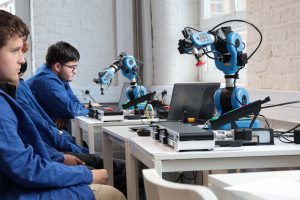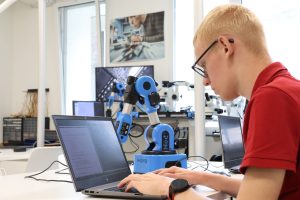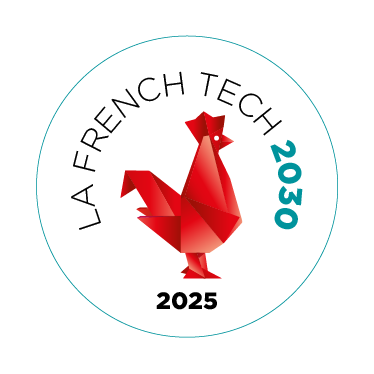The convergence of 5G and educational robotics paves the way for a more interactive, connected, and concrete pedagogy. Niryo robots, designed for learning, demonstrate the real benefits of 5G in a school or university setting.
The digital era has profoundly transformed our societies, and the education sector is no exception. Teaching professionals are now on the front line to equip students with the necessary technological skills. The fifth generation of mobile telephony standards, the famous 5G, promises to revolutionize much more than just our communications. It is a catalyst for many applications, particularly in the field of intelligent robots.
At the same time, robotics education is establishing itself as a key discipline, offering a concrete experimental ground for abstract concepts. So how can we combine these two major advances to serve pedagogy? How can Niryo robots help you materialize key concepts for students?
The 5G revolution: much more than a simple connectivity evolution
5G is not just an improved version of 4G; it represents a true qualitative leap. Theoretical speeds up to ten times higher, extremely low latency (on the order of a millisecond), and the ability to connect a massive number of devices simultaneously. Thus, 5G redefines the limits of what is possible. These features are not limited to improving video streaming or online gaming; they open considerable opportunities in critical sectors such as 4.0 Industry, telemedicine, autonomous vehicles, and, of course, education.
For you, teachers, understanding and making others understand the implications of this technology is crucial. 5G is an essential part of the current digital transformation. It will promote the creation of more immersive, interactive, and connected teaching applications. Imagine smart campuses where information flows instantly, and where learning experiences are seamless. It is in this context that 5G becomes a powerful lever for pedagogical innovation. This is even more true when combined with other cutting-edge resources and technologies.
Educational robotics: an essential lever for 21st-century skills
Today, integrating robotics education into school and university curricula is a necessity. Far beyond assembling components, educational robotics is a discipline that cultivates a wide range of fundamental skills.
By engaging in robotics design, construction, and programming, your students develop critical thinking skills. It also increases their ability to solve complex problems, their creativity, and their aptitude for teamwork.
Robots for learning play a central role here. They are not just simple resources but powerful educational tools that make learning more tangible. This is why there is a growing demand for educational robotics. It offers a particularly suitable learning framework for teaching STEM (Science, Technology, Engineering, and Mathematics) and introducing students to the digital world.
When 5G meets robots: a promising synergy for learning
The combination of 5G and robotic programming opens a particularly stimulating field of opportunities for educational robotics. The low latency and high bandwidth of 5G make interactions with robots that were previously difficult or even impossible, now feasible. Consider remote control of a robot: thanks to 5G, latency is so low that the experience becomes almost immediate. This paves the way for much more accurate and immersive digital scenarios.
This synergy also allows for more advanced collaboration between multiple robots and other connected objects. For embedded artificial intelligence applications, the ability to quickly process large amounts of information to the cloud thanks to 5G increases the possibilities tenfold. This enables you to develop more ambitious projects that more closely target industrial applications and meet current technological challenges. This will make learning even more relevant.
Towards a new era of practical experimentation
Incorporating 5G into your educational robotics initiatives could lead to tangible progress for students:
- Teleoperation of robots with unmatched fluidity and precision, allowing exploration of complex scenarios remotely.
- The ability to collect and analyze large volumes of data in real time from multiple sensors, enriching robotic programming projects.
- The possibility to simulate on a small scale but realistically connected production environments typical of 4.0 Industry.
- Experimentation with more sophisticated AI algorithms, thanks to fast access to remote computing resources.
Niryo: your partner for exploring the 5G-robotics convergence
Faced with these changes, it is crucial to have the appropriate tools. This is where Niryo enters the game. Its mission is to make educational robotics accessible and relevant. This is achieved through collaborative robots specifically designed for teaching and research. These programmable robots are ideal for introducing your students to modern robotic programming concepts, and they now open the door to exploring the opportunities offered by 5G.
Niryo’s solutions are not limited to hardware. Niryo incorporates easy-to-use software and comprehensive educational documentation. By using a Niryo robot, you are not just teaching robotic programming, you are offering a window into the technologies that will shape the future, including the interaction between a robot and next-generation networks such as 5G.
We believe that tools like ours can greatly facilitate the integration of these advanced concepts into your programs.

Practical teaching applications with Niryo and the 5G vision
How exactly can Niryo robots be used to demonstrate the benefits of 5G in an educational setting? Imagine a scenario where a Niryo robot is controlled via a 5G network connection, then via an older connection. Your students could directly observe and quantify the improvement in responsiveness and precision, and understand the impact of latency on remote control.
You could also develop student projects where connectivity is a central issue. For example, real-time coordination of several Niryo robots. The goal here is to accomplish a collaborative task or the interaction of a robot with a set of connected objects (IoT) via a high-performance local network.
These practical experiences are invaluable for preparing your students for the realities of the digital world and 4.0 Industry. The latter is, moreover, the convergence of robots, AI, and ultra-high-performance networks.
Developing tomorrow’s skills today
By integrating such demonstrations and projects into your courses, you enable your students to acquire:
- A deep understanding of next-generation networks and their impact on robotic systems.
- A more advanced mastery of robotic programming in connected and demanding contexts.
- The ability to design, integrate, and manage complex technological systems, a key skill for their future careers.
- Awareness of the challenges of advanced educational robotics and digital applications.
















